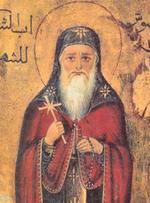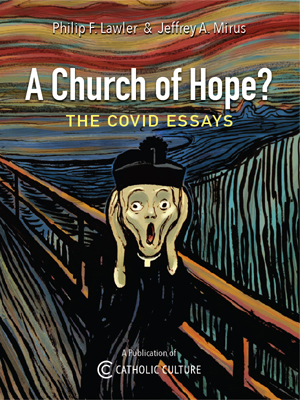Subscribe for free today!
Get newsletters with the latest content, and access to exclusive ebooks and podcast episodes.
Already subscribed? Log in to stop seeing invitations to subscribe.
Each of us is destined to marry Jesus Christ
By Dr. Jeff Mirus ( bio - articles - email ) | Sep 18, 2014 | In Reviews
Long ago and far away (I mean the mid-1970s in North Carolina), I wrote a book. Trained as an historian but always more interested in evangelization, I decided to do a sort of popular survey of history from creation to the end of the world. The purpose was to trace the action of God in His plan of salvation, and also to explain the rise of Christian culture, as well as its subsequent collapse into secularism, while stressing the undeniable destiny of the Mystical Body of Christ. In other words, this project was what we call “salvation history”.
The modest 185-page book was published in 1978 about a year after I had helped to found Christendom College, with an introduction by the main founder and president, Warren H. Carroll. Carroll ultimately authored a much more ambitious and very different multi-volume history of the rise, development and decline of Christendom—that is, the Western world under the influence of Christ. Meanwhile, my book was brought out by a small Catholic press which has since ceased to exist, in a small edition annoyingly rife with typographical and layout errors. I regretfully recall that my ego was quite fragile at the time. But it was no doubt a typically wise decision of Providence that the book was not destined for greatness.
For today’s topic, there are only three points about the book which have any importance. First, the book’s title was The Divine Courtship. Second, the title of the closing chapter (which takes the reader to the vision of St. John in the Apocalypse) was “The Bride of Christ”. And third, the last line was this: “The history of salvation is the making of our wedding gown.”
And now, thirty-six years later, a young whippersnapper of an upstart, who teaches at Notre Dame Seminary in New Orleans, whose five children have not yet grown up and left the nest, and who goes by the unusual name of Brant Pitre, has a new book out from Image (Random House) entitled Jesus the Bridegroom: The Greatest Love Story Ever Told.
How could I resist?
Powerful Exegesis
Pitre may be relatively young, but he is no newbie. A widely-sought speaker, he has already established his bona fides as an author in a 2011 book, also from Image, entitled Jesus and the Jewish Roots of the Eucharist: Unlocking the Secrets of the Last Supper. This earlier project provides a significant clue to his stock in trade. Brant Pitre is as good as anybody at mining both the Old Testament and the traditions of Judaism so that the full depth and impact of the actions of Christ can be properly understood.
This is exactly what the author does so skillfully in Jesus the Bridegroom. He explores “the Divine love story” in the Old testament, uncovering the theme of God as the Bridegroom, the Jewish people as His adulterous spouse, and the New Covenant with the Church as His forgiven bride. Against the background of Jewish marriage customs, he explains why John the Baptist referred to Our Lord as the Bridegroom, unlocks the full significance of the miracle at Cana, and highlights the significance of the Last Supper as a wedding feast.
In subsequent chapters, Pitre meditates on the “woman at the well”, a Samaritan woman representative in some ways of both Jews and Gentiles, to show the spousal implications of that scene. Beginning with the community well as the place where Old Testament figures sought their wives, he goes on to draw parallels between the living water which Christ offers and the traditional Jewish bridal bath. This leads to a deeper recognition of the flow of water from Christ’s side at the moment of His death, symbolic of His washing of the Church, which was completed immediately in His very blood.
The author also clearly explains that the Crucifixion is meant to be understood as Christ’s wedding day—the day on which he forgives his unfaithful spouse and takes her again, pure and spotless, as his renewed bride. As I’ve already hinted in mentioning my own book, there is a strong nuptial theme in the book of Revelation. Brant Pitre rightly sees the culmination of history as the consummation of the Church’s marriage to her Lord. Here he also makes the important point that the main reason there is no marrying between man and woman in Heaven (Mt 22:30) is that all the faithful are married to God.
Wonderfully Accessible
In a final chapter, Pitre explains the bridal meaning of the sacraments of baptism, Eucharist and, of course, matrimony, as well as the bridal significance of consecrated virginity. This enables the reader to move from understanding the nuptial mystery of salvation as a wonderful story to experiencing that meaning in his or her own life.
It is, in fact, characteristic of the entire book that the author wants his readers to grasp these realities personally, rather than simply to note them as the subject of a scholarly monograph. Though replete with Scriptural citations and allusions to Jewish practices that we know from other sources, the text is always straightforward and engaging—all the more powerful because the nuptial themes are presented not simply as superb Scriptural interpretation but as present reality.
Because I was already familiar with most of the threads which are woven into Pitre’s narrative, I was able to skim through the book very quickly. This is a compliment to the author’s ability to make perfectly clear to the reader what he intends to demonstrate at each step of the way. I could jump over the things I knew, while slowing down to savor information from Jewish cultural history which was foreign to me, and especially to appreciate key passages in Scripture that I had not tied together so wonderfully in the past.
On the other hand, those for whom much of this is new could slow way down, not because the book is dense or hard to follow, but because it is such a rich stimulus to meditation for all those who have not yet had the opportunity to explore its nuptial themes. It is hard to imagine anyone doing a better job with this material for an unspecialized audience than Pitre has done.
Brad Pitre has written the history of our salvation simply by interpreting the person of the Bridegroom. It is He, after all, who is “the Alpha and the Omega, the first and the last, the beginning and the end” (Rev 22:13). Indeed, all of Scripture points to this scene in the Book of Revelation:
Then I heard what seemed to be the voice of a great multitude, like the sound of many waters and like the sound of mighty thunder peals, crying, "Hallelujah! For the Lord our God the Almighty reigns. Let us rejoice and exult and give him the glory, for the marriage of the Lamb has come, and his Bride has made herself ready; it was granted her to be clothed with fine linen, bright and pure”—for the fine linen is the righteous deeds of the saints. And the angel said to me, “Write this: Blessed are those who are invited to the marriage supper of the Lamb.” [Rev 19:6-9]
As the angel also stressed to St. John: “These are true words of God.”
All comments are moderated. To lighten our editing burden, only current donors are allowed to Sound Off. If you are a current donor, log in to see the comment form; otherwise please support our work, and Sound Off!
-
Posted by: dover beachcomber -
Oct. 04, 2014 12:13 AM ET USA
In this era when sexual confusion is so rife, it sounds highly awkward to me to say that "each of us is destined to marry Jesus Christ." Sure, as C. S. Lewis put it, there is a sense in which all of us are "feminine" to God's "masculine." But is that reality best described by a word that, here on earth, can't be separated from its sexual context? It seems a very long leap from the Church as the Bride of Christ, to each one of us individually as a Bride of Christ.








